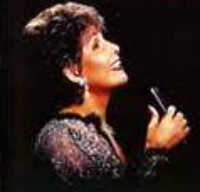 Lena Horne, the electrifying beauty and uncompromising performer, shattered racial boundaries by changing the way Hollywood presented black women for six-decades through a singing career on stage, television and in films.
Lena Horne, the electrifying beauty and uncompromising performer, shattered racial boundaries by changing the way Hollywood presented black women for six-decades through a singing career on stage, television and in films.
She is best described in her own words saying “my identity was clear because I no longer have to be a 'credit,' I don't have to be a 'symbol' to anybody. I don't have to be a 'first' to anybody. I don't have to be an imitation of a white woman that Hollywood sort of hoped I'd become. I'm me, and I'm like nobody else.”
Lena Mary Calhoun Horne was born June 30, 1917, in Brooklyn, N.Y. Her father was a civil servant and gambler who largely abandoned the family. Her mother, an actress, was largely absent from Ms. Horne's early life because of work on the black theater circuit. Shifted at first among friends and relatives, Ms. Horne was raised mostly by her maternal grandmother, a stern social worker and suffragette in Bedford-Stuyvesant; then a middle-class Brooklyn neighborhood. Ms. Horne said she was influenced by her grandmother's "polite ferocity."
She was the first black woman to sign a meaningful long-term contract with a major studio, a contract that said she would never have to play a maid. This single act transformed the image of the African American woman in Hollywood. As film historian Donald Bogle said, "Movies are a powerful medium and always depicted African American women before Lena Horne as hefty, mammy-like maids who were ditzy and giggling… Lena Horne becomes the first one the studios begin to look at differently... Really just by being there, being composed and onscreen with her dignity intact paved the way for a new day" for black actresses.
Her reputation in Hollywood rested on a handful of classic musical films. Among the best were two all-black musicals from 1943: "Cabin in the Sky," as a small-town temptress who pursues Eddie "Rochester" Anderson; and "Stormy Weather," in which she played a career-obsessed singer opposite Bill "Bojangles" Robinson. She shared billing with hugely famous white entertainers such as Gene Kelly, Lucille Ball, Mickey Rooney and Red Skelton but was segregated onscreen so producers could clip out her singing when the movies ran in the South.
Metro Goldwyn Mayer studios featured Ms. Horne in movies and advertisements as glamorously as white beauties including Hedy Lamarr, Rita Hayworth and Betty Grable. James Gavin, who has written a biography of Ms. Horne, said: "Given the horrible restrictions of the time, MGM bent over backward to do everything they could. After MGM, she was an international star, and that made her later career possible, made her a superstar."
Ms. Horne appeared on television and at major concerts halls in New York, London and Paris. She starred on Broadway twice, and her 1981 revue, "Lena Horne: The Lady and Her Music," set the standard for the one-person musical show, reviewers said. The performance also netted her a special Tony Award and two Grammy Awards. She was formidable and the first black cabaret star for white society.
As a songstress her repertoire consisted of sophisticated ballads of Cole Porter, George and Ira Gershwin, Frank Loesser and Billy Strayhorn. She loved the music but also said she liked surprising the white audience who expected black entertainers to sing hot jazz or blues and dance wildly. In her singing, Ms. Horne showed great range and could convincingly shift between jazz, blues and cabaret ballads. New Yorker jazz writer Whitney Balliett praised her "sense of dynamics that allowed her to whisper and wheedle and shout."
In 1963, Ms. Horne appeared at the civil rights March on Washington with Harry Belafonte and Dick Gregory and was part of a group, which included authors James Baldwin and Lorraine Hansberry that met with Attorney General Robert F. Kennedy to urge a more active approach to desegregation.
Ms. Horne also used her celebrity to rally front-line civil rights activists in the South and was a fundraiser for civil right groups including the NAACP and the National Council of Negro Women. After the triumph of her 1981 Broadway show, she led an increasingly isolated life in her Manhattan apartment.
Over my lifetime I have seen and known giants who have illuminated the world. No star has shined brighter than “The Horne”. Ms. Horne as you take your rest among the ghost of the greats now belong to the ages. And that’s my Thought Provoking Perspective…









No comments:
Post a Comment